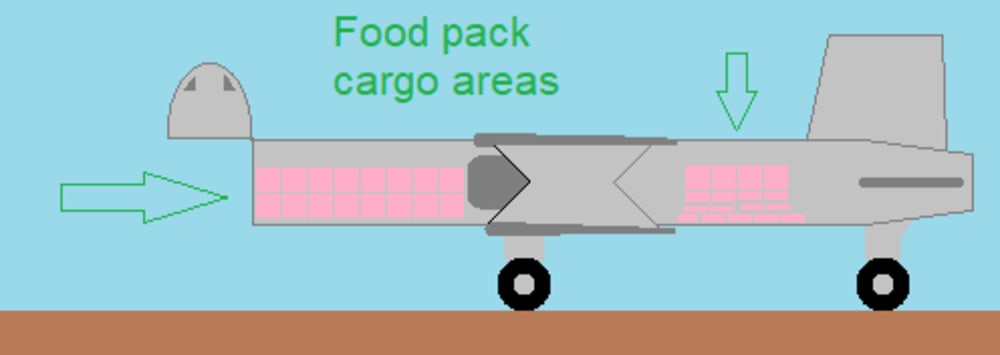There are places where food aid is hard to deliver by road. This drone carries more Humanitarian Daily Rations for a longer distance than quadcopter drones can. Humanitarian daily rations are a specific form of aid that is designed to be dropped from planes. The drone may also carry juice packs, and other light objects that can survive being dropped without parachutes.
How it works:
Aid workers would have reports of people who needed food, but were cut off from road deliveries. They would load the drone with trays of HDRs to be dropped and upload a location and map via USB. Then the drone would be launched from a relief headquarters parking lot or bulldozed runway and navigate to the drop site by GPS. The drone would be equipped with multispectral cameras and a radar altimeter. When it flies over the anticipated drop site, flying at an altitude of 500-1,500 ft, the drone will look for beacons or fires. For safety reasons, It will also look for groups of people and check if it is over water (as suggested by Aki Suokas in his 2003 entry), and try to find an unoccupied spot on dry land nearby to drop the supplies so they don’t hit anyone or fall in the water. The supplies will be individual packs in a tray that rotates upside down to dump the supplies. Then it flies back past the launch site, does a U-turn and looks for the landing beacon.
Market Potential and Competition:
The Food Aid Delivery Drone would be used to drop food in places like Gaza, Haiti, and Sudan. It has limited market potential, because it is only intended for delivering food aid to groups of refugees that need air droppable food packs, but it is not usable for general use where it would have to deliver breakable things to specific addresses. A drone already in the marketplace that could be used instead is Elroy Air's Chaparral system, which has a long range and ability to land and detach the load of supplies it carries. However, the Food Aid Delivery Drone should be able to deliver more food packs than Elroy Air's drone, depending on the final size chosen for the Food Aid Delivery Drone.
Construction:
The drone would be built as a tube, about 30 feet (or 10 meters) long. The front end would have the cameras and sensors and flip up so a new tray of supplies can be loaded quickly. The next section holds the supplies. The last section, from the wings back, holds fuel, computers, and maybe an extra supply compartment. The drone is powered by two small engines, and built as a biplane so the wingspan can be smaller and less awkward to transport.
Like this entry?
-
About the Entrant
- Name:Eric Puravs
- Type of entry:individual
- Patent status:none

